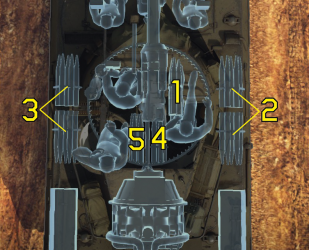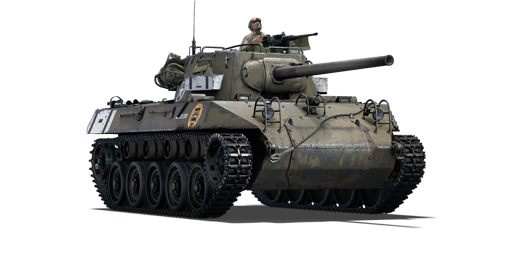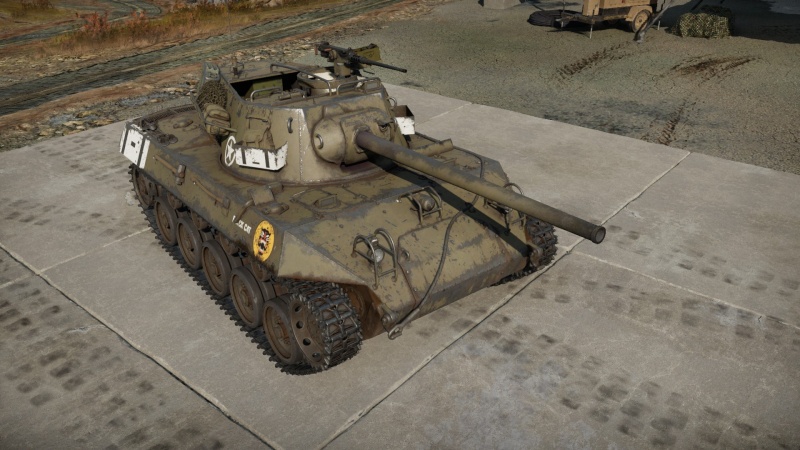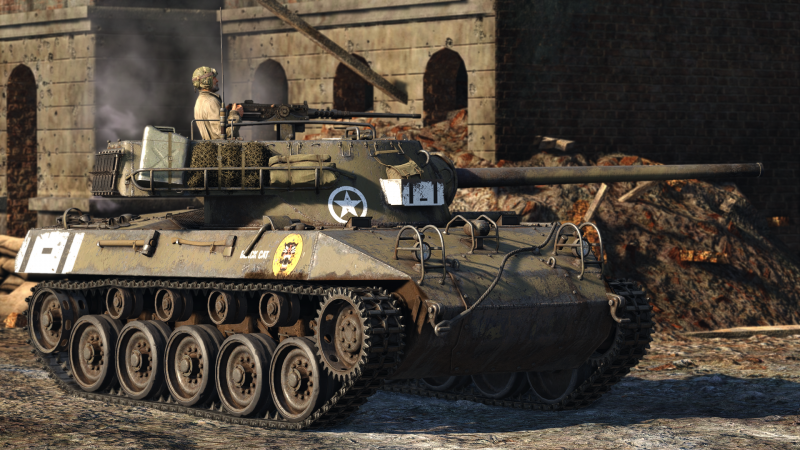M18 "Black Cat"
| This page is about the American light tank M18 "Black Cat". For other versions, see M18 Hellcat (Family). |
Contents
Description
The M18 Gun Motor Carriage "Black Cat" is a premium rank III American light tank
with a battle rating of 5.3 (AB) and 6.0 (RB/SB). It was introduced in Update 1.49 "Weapons of Victory" as a premium pack vehicle and was eventually removed from the store after War Thunder's 6th Anniversary sale, but was later reintroduced for War Thunder's 7th anniversary as a premium purchasable in-game with Golden Eagles ![]() .
.
The M18 "Black Cat" is a gift version of the M18 Hellcat, with little difference in performance.
The M18 "Black Cat" compensates the lack of anti-tank capability on U.S vehicles by having access to a 76 mm gun with APCR ammunition. This makes the M18 able to fight off many of the common vehicles it could face like the Panther D, Tiger H1, KV-1, KV-85, and IS-1.
Unlike the other tank destroyers known in the game, the M18 "Black Cat" has access to a 360° traversable turret, allowing players to have a greater arc of fire than a typical casemate tank destroyer like the StuG III, but at the expense of a slightly higher profile. Americans tank destroyers also have very high manoeuvrability compared to other nation's tank destroyers, allowing it to flank the enemy.
General info
Survivability and armour
The main weak point of M18 is its very thin armour, a feature that actually allows the M18 to reach its high speed. The thin armour makes it possible for any enemy tanks to penetrate the vehicle. A single hit would destroy many critical components in the M18 or cripple the crew. The only saving grace is that standard AP rounds may over-penetrate the armour, doing minimal damage to the internals. Thus, when facing the M18, it's best to use AP rounds with explosive fillers or HE and HEAT rounds while avoiding usage of pure AP rounds and APCR.
Armour type:
- Rolled homogeneous armour (hull, turret)
- Cast homogeneous armour (gun mantlet)
| Armour | Front (Slope angle) | Sides | Rear | Roof |
|---|---|---|---|---|
| Hull | 12.7 mm (39-64°) Front glacis 12.7 mm (23-52°) Lower glacis |
12.7 mm (23-26°) Top 12.7 mm Bottom |
12.7 mm (12°) Top 12.7 mm (36°) Bottom |
8 mm |
| Turret | 25.4 mm (15-26°) Turret front 19 mm + 25.4 mm (0-55°) Gun mantlet |
12.7 mm (1-21°) | 12.7 mm (7°) | N/A Open-top 8 mm Bustle and Front |
Notes:
- Suspension wheels and tracks are 15 mm thick.
- Belly armour is 5 mm thick.
- The hull underside right above the tracks are only 8 mm thick.
- Tracks are attached the turret rear, granting some 15 mm in thickness.
Mobility
| Game Mode | Max Speed (km/h) | Weight (tons) | Engine power (horsepower) | Power-to-weight ratio (hp/ton) | |||
|---|---|---|---|---|---|---|---|
| Forward | Reverse | Stock | Upgraded | Stock | Upgraded | ||
| Arcade | 90 | 29 | 17.7 | 620 | 878 | 35.03 | 49.6 |
| Realistic | 81 | 26 | 354 | 460 | 20 | 25.99 | |
Modifications and economy
Armaments
Main armament
The 76 mm M1 cannon is an extremely capable gun with a high damage potential and a very good gun handling. It is one of the most widely used guns throughout rank III and with M18 being the first tanks to use it, it gives it a very high penetration power. Once upgraded, the turret has very fair guidance in both: horizontal and vertical axis allowing to quickly catch pot-shots, though given exceptional mobility of the platform even it struggles to catch up with the near-instant hull rotation.
| 76 mm M1 | Turret rotation speed (°/s) | Reloading rate (seconds) | |||||||||||
|---|---|---|---|---|---|---|---|---|---|---|---|---|---|
| Mode | Capacity | Vertical | Horizontal | Stabilizer | Stock | Upgraded | Full | Expert | Aced | Stock | Full | Expert | Aced |
| Arcade | 45 | -10°/+20° | ±180° | N/A | 22.8 | 31.6 | 38.4 | 42.5 | 45.2 | 7.93 | 7.02 | 6.47 | 6.10 |
| Realistic | 14.3 | 16.8 | 20.4 | 22.6 | 24.0 | ||||||||
Ammunition
| Penetration statistics | |||||||
|---|---|---|---|---|---|---|---|
| Ammunition | Type of warhead |
Penetration @ 0° Angle of Attack (mm) | |||||
| 10 m | 100 m | 500 m | 1,000 m | 1,500 m | 2,000 m | ||
| M79 shot | AP | 134 | 132 | 121 | 109 | 99 | 89 |
| M42A1 shell | HE | 7 | 7 | 7 | 7 | 7 | 7 |
| M62 shell | APCBC | 149 | 146 | 133 | 119 | 106 | 95 |
| M93 shot | APCR | 190 | 186 | 167 | 146 | 128 | 112 |
| Shell details | |||||||||
|---|---|---|---|---|---|---|---|---|---|
| Ammunition | Type of warhead |
Velocity (m/s) |
Projectile mass (kg) |
Fuse delay (m) |
Fuse sensitivity (mm) |
Explosive mass (TNT equivalent) (g) |
Ricochet | ||
| 0% | 50% | 100% | |||||||
| M79 shot | AP | 792 | 6.8 | N/A | N/A | N/A | 47° | 60° | 65° |
| M42A1 shell | HE | 823 | 5.84 | 0 | 0.1 | 390 | 79° | 80° | 81° |
| M62 shell | APCBC | 792 | 7 | 1.2 | 14 | 63.7 | 48° | 63° | 71° |
| M93 shot | APCR | 1,036 | 4.22 | N/A | N/A | N/A | 66° | 70° | 72° |
| Smoke shell characteristics | ||||||
|---|---|---|---|---|---|---|
| Ammunition | Velocity (m/s) |
Projectile mass (kg) |
Screen radius (m) |
Screen deploy time (s) |
Screen hold time (s) |
Explosive mass (TNT equivalent) (g) |
| M88 | 274 | 3.44 | 13 | 5 | 20 | 50 |
Ammo racks

| Full ammo |
1st rack empty |
2nd rack empty |
3rd rack empty |
4th rack empty |
5th rack empty |
Visual discrepancy |
|---|---|---|---|---|---|---|
| 45 | 37 (+8) | 27 (+18) | 17 (+28) | 9 (+36) | 1 (+44) | No |
Notes:
- Turret empty: 37 (+8) shells.
- When fighting in downtiers it's best to take only 17 shells, which allows the turret and sides of the tank to be empty of shells, notably increasing survivability. Otherwise, it doesn't matter how many rounds are loaded, as most hits against the tank will prove deadly regardless.
Machine guns
| 12.7 mm M2HB | ||||
|---|---|---|---|---|
| Mount | Capacity (Belt) | Fire rate | Vertical | Horizontal |
| Pintle | 800 (200) | 576 | -10°/+70° | ±60° |
Usage in battles
Before all, avoid colourful or bright decals. Camouflage is the main part of the M18's defence. Chances for good performance in battle are: be "invisible", fast and effective. The M18's speed is its best ally. This speed has to be used for flanking manoeuvres and relocate. Not for trying to cross an open field, that will leave it open to enemy fire, speed is not a substitute for armour.
Relocate
This movement will have to be done again and again. Choose a good spot wisely, remove the foliage if necessary to get a clear field of fire. When in the fire spot, use the gun depression and stay in a hull down position until a target is located. Once a target is locked on, aim at critical components. Try to immobilize the enemy by firing at the engine or transmission, or remove their firepower by shooting the gun or breech, or for instant destruction with an aim at the ammo storage. The last option can work very well or not, as skilled players only carry a few rounds of ammo.
If positive that the enemy hasn't discovered the firing spot, go for another shot. Stay attentive that none of the enemy's teammates has also located the firing spot. If detected, hide immediately and relocate.
Flanking
Flanking is the most dangerous manoeuvre of all because the vehicle will have to be exposed as it moves to the enemy's rear, but it is very effective when it's coordinated with other vehicles. A distraction is needed to gain the enemy's attention while the M18 makes its move. Isolated enemy units are very vulnerable to this tactic. Using the M18 speed to get to the rear and as the enemy heads toward the objective, the firing perspective should give a very clear view of the enemy's side armour. A good shot with the M62 APCBC shell could knock out the enemy rather quickly, but if using solid AP shots like the M79, aim at critical components on mobility and firepower before knocking out the crew or ammo stowage.
Avoid flat terrain
Flat terrain means that the Hellcat will become an easy target for virtually any vehicle by exposure, especially when not moving or when moving in a straight line. Open plains are the bane of the Hellcat. Whenever possible, one should try to stay amongst hills.
Pros and cons
Pros:
- Overall mobility is superb, with very responsive manoeuvring that allows the Hellcat to excel in flanking manoeuvres
- Fast reload speed and turret traverse
- M62 APCBC round has great penetration and lots of explosive fillers, rarely requiring more than one penetrating shot to knock out common tanks like M4s, Tiger H1 or Panthers
- Low profile, reducing target size and allows it to hide behind small bushes or rocks easily
- The nature of its thin armour means AP rounds have a tendency to pass straight through without damaging modules, and an APHE fuze may not even be triggered. For example the Soviet 122 mm will over-penetrate, dealing little damage
Cons:
- Thin armour means rapid-fire autocannons, heavy machine guns, and aerial weapons could easily shred it. Beware of the R3 T20 FA-HS, IL-2 and Wirbelwind
- Commander is exposed at the 0.50 calibre machine gun mount, and knocking him out would render the weapon useless
- Open-top construction means aerial strikes and artillery could rain havoc onto the crew
- Gun has poor penetration in an uptier, often can't penetrate anything frontally unless hitting a weak spot. The Ho-Ri, Tiger II (H) and M26 are frontally immune to this 76 mm M1
- Rarely reaches 50 km/h in Realistic Battles, even in a straight line, therefore can be outran by the Sd.kfz.234 series or the R3 T20 FA-HS
- A moment of immobility due to a damaged engine or transmission could be a sign of impending doom for the M18
- Overpressure mechanic means any HE shells, artillery strike, bomb or rocket could instantly destroy the vehicle
History
US Tank Destroyer Doctrine
The anti-tank doctrine established by the US military called for fast, powerful vehicles able to stop the German blitzkrieg tactics by ambushing the attacking tank forces. Unlike the other armoured fighting vehicles in the theatre, the tank destroyers were made to be placed in reserves to counter any breach in the front lines by taking out the enemy with ambushes. This role led to the desire for a fast vehicle with a powerful gun, the armour was not a concern due to the emphasis in speed. The initial response was the M10 GMC, made form the Medium Tank M4 Sherman hull and mounting a 3-inch M1918 gun. While adequate at this role, it was no faster than an ordinary Sherman tank. The M18 GMC was a response to the problem to provide the tank destroyer force with a very fast tank destroyer.
Development
The origin of the M18 GMC design came as early as December 1941 with the requirement of a Christie suspension and a 37 mm gun. This requirement called for a radical new tank design rather than a derivative of the M4 Sherman. These requirements changed as the war progressed, the first change was to the new and innovative Torsion bar suspension from Buick Motor Division from General Motors and another change was to mount the British QF 6-pounder gun then in use on their Churchill Mark III tanks, the developed prototype vehicle was called the T49 GMC. Then the army wanted the heavier 75 mm gun used on the Shermans on it, this prototype was designated the T67 GMC. Finally, the army decided to mount the 76 mm gun also in development for the Sherman onto the prototype, now known as T70 GMC. Changes to hull shape and turret took place to accommodate all these new requirements and armament, but it eventually was approved for service and finally renamed as the M18 GMC and started production in mid-1943, which went on until ending in October 1944 with 2,507 units produced. A variant called the M39 Armored Utility Vehicle was also produced, its turret was removed for space for cargo, 8 personnel, or to tow guns.
Combat usage
These vehicles saw combat debut in the summer of 1944, where they are given the unofficial nickname "Hellcat" by the crews using them. Unlike the M10 tank destroyer that was built before it, the M18 GMC was purely made for emphasis on speed. Armour was restricted down to a maximum of 1-inch (25 mm) on the turret front while the rest of the body plating is a measly .50-inches thick (12.7 mm). The turret was also an open-top design similar to the M10 tank destroyer, meaning the crew are left exposed to the elements and enemy fire and shrapnel. These faults were mitigated by the fact that as its role as a tank destroyer, it was to have minimum contact with infantry and ambush enemy tanks in concealed position rather than face them in an offensive operation. Nevertheless, the M18 GMC were well liked by the crew for its 76 mm cannon, which allows it to destroy the newer German Tiger Is and Panthers tanks from the front with HVAP ammo (though the Panther at close range only) when unable to flank around to the side or rear of these tanks. The speed was also astounding, reaching 55 mph maximum, this makes the M18 GMC the fastest armoured fighting vehicle in World War II and was not succeeded until the third-generation main battle tank M1 Abrams. The name "Black Cat" came from the 805th Tank Destroyer Battalion, Company B where the naming practice for the battalion was the first letter of the company, then "Cats". Thus, a crew in Company B named their hellcat the "Black Cats".
While use in the Pacific theatre was limited due to the inadequate armour of Japanese tanks, it saw most of its service in the European theatre against Nazi Germany. Due to the lack in armour and emphasis on speed, the M18 crews utilize the "shoot and scoot" tactic in attacking the enemy from one position and quickly move to another before the enemy could find their initial firing position, this tactic confuses the German tanks, and could even lead them to believe there are more armoured enemy than what it appears. The M18 GMCs were present during the Battle of Arracourt in France as the 704th Tank Destroyer Battalion. Lt. Edwin Leiper led an M18 platoon of C Company and in the battle knocked a total of 15 German tanks for the loss of three M18; six of these German tank kills, most of which were Panthers, were credited to one M18 led by Sgt Henry R. Hartman. The M18 also played a crucial part in the Battle of the Bulge, where its top speed of 55 mph was finally put to good use in bypassing the enemy forces. Four M18 tank destroyers of the 705th Tank Destroyer Battalion assisted the 506th Parachute Infantry Regiment in attacking the 2nd Panzer Divison and their support to kill the fuel lines to the German tanks. The overall attack had the M18 GMCs credited with at least 24 tank kills of the 30 total inflicted in the attack.
Legacy
Overall, the M18 GMC proved itself by having the highest kill to lose ratio to any other tanks and tank destroyer in American service, making it the most effective tank destroyer in American service. However, like its other tank destroyer brethren, it soon found itself obsolete along with the entire tank destroyer doctrine. Mainly due to increasing prevalence of well-armoured tanks that could do its job more efficiently such as the M26 Pershing, but also the lack of German AFVs at the time of the war and a study on ammo usage indicates that the tank destroyers spent more time supporting infantry with high-explosive shells than killing tanks with armour-piercing, rendering the anti-tank section an unnecessary component in the modernizing armoured forces.
Today, some countries in the world such as Yugoslavia still have the M18 Hellcats in reserves.
| Archive of the in-game description | |
|---|---|
|
The 805th's M18 antitank vehicle was one of the most flamboyant. Its tactical designation was drawn in white against a black background. On the sides of the turret and body were white areas with two vertical black stripes and one horizontal one. On the sides of the body next to the mechanic's station was a roundel of a cat biting through the body of the tank. It was the custom in the division to give their vehicles names, but the first letter of the "name" had to be the same as the company's letter. So the first vehicle in company B was called "Black Cat". | |
Media
- Skins
- Images
See also
Links to the articles on the War Thunder Wiki that you think will be useful for the reader, for example:
- reference to the series of the vehicles;
- links to approximate analogues of other nations and research trees.
External links
| Buick Division of General Motors | |
|---|---|
| Tank Destroyers | M18 GMC · M18 "Black Cat" · Super Hellcat |
| Export | ␗M18 GMC · ▄M18 |
| Note | Buick is a division of General Motors (GM). |
| USA light tanks | |
|---|---|
| LVT | LVT(A)(1) · ○LVT(A)(1) · LVT(A)(4) |
| M2 | M2A2 · M2A4 · M2A4 (1st Arm.Div.) |
| M3/M5 Stuart | M3 Stuart · M3A1 Stuart · M3A1 (USMC) · M5A1 · M5A1 TD · ▃Stuart VI (5th CAD) |
| M22 Locust | M22 |
| M24 Chaffee | M24 · M24 (TL) |
| M18 Hellcat | M18 GMC · M18 "Black Cat" · Super Hellcat |
| M41 Walker Bulldog | M41A1 |
| M551 Sheridan | M551 · M551(76) |
| M3 Bradley | M3 Bradley · M3A3 Bradley |
| Wheeled | M8 LAC · T18E2 · M1128 · M1128 Wolfpack |
| Other | M8A1 GMC · T92 · T114 · HSTV-L · CCVL · XM8 · XM800T · AGS |
| USA premium ground vehicles | |
|---|---|
| Light tanks | LVT(A)(4) · M2A4 (1st Arm.Div.) · M3A1 (USMC) · ▃Stuart VI (5th CAD) · M8 LAC · M8A1 GMC |
| M18 "Black Cat" · Super Hellcat · T18E2 · M551(76) · T114 · M1128 Wolfpack | |
| Medium tanks | ▃Grant I · M4A5 · Calliope · T20 · M26 T99 · M26E1 · M46 "Tiger" · T54E1 · T54E2 · ▃Magach 3 (ERA) · M728 CEV |
| XM1 (GM) · XM1 (Chrysler) · M1 KVT · M1A1 Click-Bait | |
| Heavy tanks | T14 · Cobra King · M6A2E1 · T29 · T30 |
| Tank destroyers | T28 · T55E1 |







